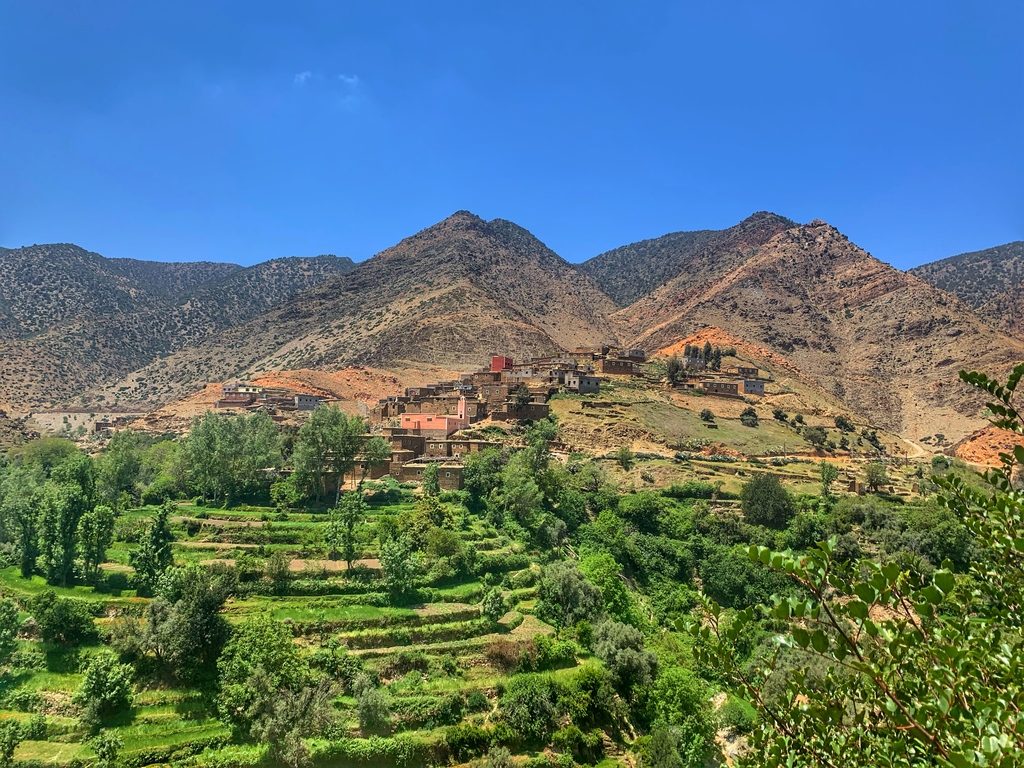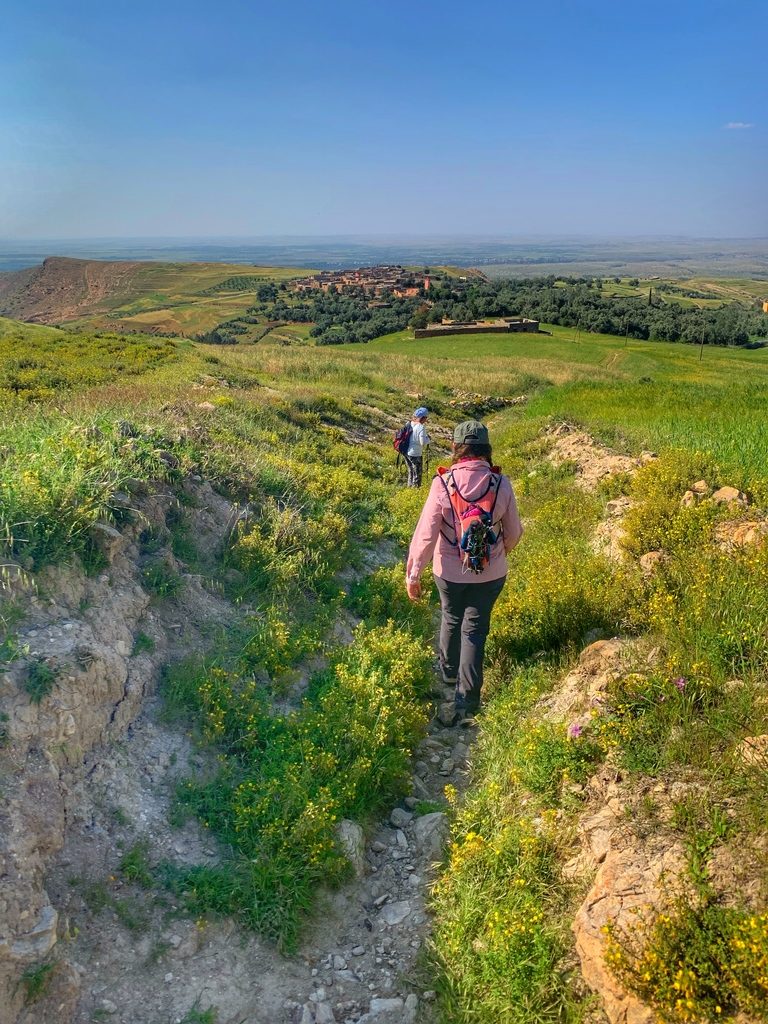The Amizmiz Trail

Morocco is a hikers’ paradise. There are a huge number and variety of walks you can undertake from conquering North Africa’s highest peak, Mount Toubkal at 4,167 metres (13,671 ft) to taking on the desert and the sand dunes of the Sahara.
The High Atlas are the country’s principle mountains and is the longest and most significant range in Africa, stretching all through Morocco, Algeria and into Tunisia- a distance of 2,500 km (1,600 mi).
In Morocco, the mountains form a natural barrier between the desert and the Atlantic and Mediterranean seas. In the Amazigh (Berber) languages the word for mountain is adrar/ adras which is thought to derive from Atlas. Atlas is also the root of the word Atlantic.
According to Greek mythology, Atlas was a Titan who tried to rebel against the gods by leading his people in battle against them, hoping to win control of the heavens. As any of us who have tried, have found, the gods always win and that was the case for the ill-omened Atlas and his Titans. Zeus, the head of the gods, condemned the Titan army to a deep dungeon in the abyss called Tartarus, but Atlas was imprisoned for eternity between heaven and earth. For the sin of pride in his own strength, he was given the task of holding up the heavens for all eternity. Loop up to the summit of Mount Toubkal, towering above you at dawn or dusk, and you will catch a glimpse of him frozen in stone, the weight of the sky on his shoulders.
In Morocco, the mountains are divided into three sections; the High Atlas, the Middle Atlas, and the Anti Atlas. The High Atlas rises in the west at the Atlantic coast and stretches in an eastern direction to the Moroccan-Algerian border. At the Atlantic and to the southwest, the range drops sharply to the coast and the Anti-Atlas range. It is the closest range to Marrakech, with hiking expeditions centered around the trekking hub of Imlil and other centres for shorter trips like Setti Fatma and Ouirgane.
These are all great places to start a trek but one that is virtually unknown and has been pioneered by Epic is the Amizmiz trail. This circular route is easily doable in a day, with an early start from Marrakech to the regional town of Amizmiz, where you will stop for a coffee and to meet your guide. We are proud of all our guides at Epic, and Latifah is not an exception. She is one of only a handful of female Moroccan mountain guides and is an Amizmiz local.

The walk starts with a steep downhill scramble amongst a gaggle of cactus plants. The fruit from these plants is delicious and is sold on the streets during the summer for a few dirhams but the thick, juicy leaves are also used. They exude a thick sap which is a natural antiseptic. It is squeezed out and mixed with honey and is an excellent treatment for bedsores and chronic wounds.
The people here are farmers and there are smallholdings all across the hills, fed by water brought up from the river in the valley. Wheat, barley and vegetables such as courgettes, carrots, onions and peas are shaded by fruit trees. It is mainly subsistence farming is still done in the traditional way. Ploughing is with wooden ploughs pulled by donkeys and no artificial fertilisers or pesticides are used. After crossing the river, the path winds up through a shaded area passing traditional Berber (Amazigh) villages on the way. The houses are made of adobe, compressed clay, and are roofed in timber with grass at the edges to help with letting the water flow off the top if it rains. The windows have a distinct white border which is a way to keep the ants out of the house in the summer. When the sun heats up the white paint, it becomes too hot for them to cross.
The next section of the walk winds up and along the hillside. There is plenty of climbing but the views are rewarding. You see the length of the valley as it cuts through the mountains. It’s an area rich in wildflowers if you come in spring or early summer with vibrant patches of purple and yellow. Keep your eyes open for carob trees that grow along the side of the path. Shepherds pass with their herds of goats and the sound of them bleating echoes across the hills.
At last, you reach the top and then cross over onto a wide plain. Here you will see a new orchard of trees, each one carefully planted and watered by hand. In the nearby village, there is a welcome stop for lunch with a local family. In a traditional Berber home you are greeted with some hot, sweet tea and then treated to a meat or vegetable tagine and the bread of the mountains- tannourt. Tannourt is a big, round flatbread that is slightly crispy on the outside and softer in the middle. It is cooked on the walls of a clay oven fired by wood and has a distinct smoky taste. It’s the perfect way to scoop up the tagine – much better than a fork!
After lunch, luckily, it is mainly flat and downhill. One of the great things about this walk is that it takes you through very different types of terrain and this section is through a cool, green conifer forest. It feels more like Scotland than Morocco and when the sun is hot and the belly is full of tannourt and tagine is a welcome break.

On the way back into the town of Amizmiz, you might want to stop and buy some local honey. It is famous in the area for its taste and also for its health-giving properties as it is harvested from wild bees and not bees who have been fed on sugar beet or some other sugar-filled crop.
Before the drive back to Marrakech, there is time for a celebratory orange juice and a chance to put your feet up. On average, the hike will take around six hours with plenty of time for lunch and to explore the villages as you pass.
Epic can arrange a variety of one day or multi-day hikes in the different regions of Morocco as part of your itinerary. If you would like to do the Amizmiz trail, or any other options, just mention that when you contact us at info@epic.travel or fill in a contact form on our website https://epic.travel/contact-us/